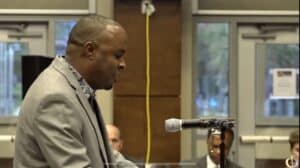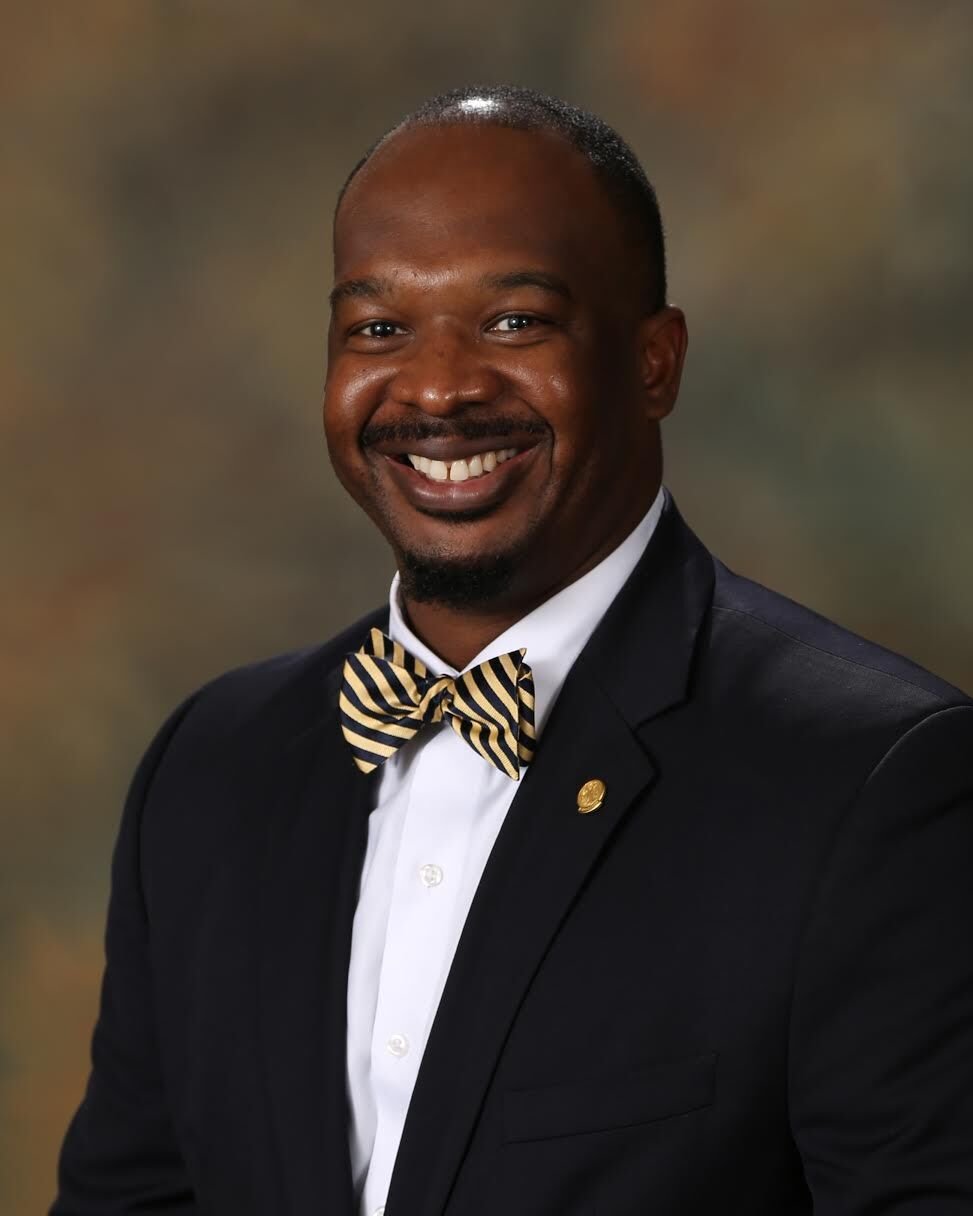
Parents, teachers, students, and administrators gathered in the Center for Advanced Technical Studies building last month to discuss the plan to open the doors of the school houses in Lexington–Richland 5 School District in the next few weeks. The parents sat neatly spaced 6 feet apart while the school board and various members of the district administration sat shoulder to shoulder: a revealing picture of the governing versus governed posture that Departments of Education and teacher’s unions around the country have taken to make their stand against parents and citizens in the community who are concerned about what they are feeding the next generation of students concerning American government.

Dr. Akil Ross. Photo courtesy Lexington-Richmond District 5.
Dr. Akil Ross, interim superintendent of Lexington Richland School District 5, gave his vision for the year with a
He also laid out his map for how to mitigate COVID-19 health emergencies taking their cues from agencies within the different areas of the counties to determine the threat level and subsequent controls necessary to engineer safety and attempt to preserve liberty in the public school system. The board presented an anti-bully app called “Stop It” designed for school children to report activity to the administrators of the schools that they, the children, deem to be abusive, threatening, or suspect. The app is one that a parent accused of being “a precursor to the social credit score” implemented in China, and in various forms like Abu Dhabi where they have even installed cameras to give tickets to citizens who violate restricted COVID-19 policies like getting within 6 feet of someone else publicly.
The public participation portion of the event kicked off with students and parents airing their complaints, grievances, and positing solutions. They shared anecdotes of family members who have suffered from COVID-19 complications and died making their case for strict obedience to the dictates of the CDC.
I was asked a week, or so ago to review some materials that are being used by the South Carolina Department of Education and to give the Lexington-Richland 5 School District a presentation on Critical Race Theory about what I had found when analyzing the aforementioned materials. I was told that the interim superintendent had made parents aware that he did not know what Critical Race Theory was, so I prepared the following presentation and delivered it.
TRANSCRIPT BELOW:
My name is Zoe Warren. I am a father of 3, I live in Lexington County, and I am a documentary and narrative filmmaker, freelance video producer, and journalist. I have been producing commercial, documentary, and news content since 2009. I have worked in local news as a camera operator and regional news as a reporter.
I am currently an editor at large for TheStandardSC, I’m the owner of Pistuo Productions, and I host a weekly show distributed by The New American Magazine addressing issues related to the second amendment titled, “2A For Today!”
My family and I are also missionaries to Pakistan and the Philippines and I am currently serving as the Lexington County Republican Party’s 3rd Vice Chair. I am not speaking as the 3rd Vice Chair of the Lexington County Republican party in this presentation. This is for me and my family.
I want to thank you all, Chairwoman, Vice Chairman, Lexington/Richland 5 school board, parents, teachers, residents of the district, United Parents of South Carolina- Midlands and Alan Wright for the opportunity to share some information related to a pedagogy called Critical Race Theory that has our nation, our state, and our counties in an uproar.
In my presentation I will endeavor to resolve generally three questions:
1. What is Critical Race Theory?
2. How is it being applied in K-12 schools despite legislation forbidding it?
3. How should we respond?What is Critical Race Theory?
Dr. Peter McLaren who is known as one of the leading architects of critical pedagogy defines Critical Race Theory as “much more than a program of study, a classroom text, or a course syllabus. Rather, it represents the introduction to a particular form of life…”
I’m going to refer to Critical Race Theory as CRT for the rest of the presentation. CRT is more than an idea: it is a form of educational warfare- sometimes in stealth, under what seems to be a helpful means of teaching the history of race relations in America, but it is meant to wash our children in race hatred using clever narratives under the guise of social and emotional education. It is put forward like a Trojan horse packed with presuppositions designed to flip the cultural hegemony through supplanting the American values of our children and replacing them with revolutionary ideals.
Dr. Nicholas Hartlep, Associate Professor of Education Studies at Berea published an important study on CRT in 2009. He is a CRT proponent and he titled his presentation “Critical Race Theory: An Examination of its Past, Present, and Future Implications”. In it he evaluated the current body of research conducted on RT- data that I will be drawing from in this section.
“CRT is broken down most succinctly in five major components, or 5 tenets:
(1) the notion that racism is ordinary and not aberrational; (2) interest convergence; (3) the social construction of race; (4) counter-storytelling; and (5) the notion that whites have actually been the beneficiaries of civil rights legislation.”
I am not going to unpack every tenet. I just want to touch on the first two and the fourth in order to help us all quickly understand how it relates to the second question that I want to address.
The notion that racism is ordinary and not aberrational begins with the fallacy that the majority culture in America is racist, “maintains elitist control,” and that whites (the majority culture) “maintain their power and stranglehold on society” (which is systemic racism.) The majority culture achieves this by determining the overall ethos of the culture and promoting the notion of “color blindness” and “meritocracy.” CRT proponents believe that “color-blindness and meritocratic rhetoric allow whites to feel consciously irresponsible for the hardships people of color face and encounter.”
They conclude that racism and white supremacy are the status quo and white oppressors exploit black and brown oppressed people by using the value of color-blindness “to claim that they are neutral.” So, “color-blindness” is no longer an American value in the world of CRT proponents.
Neither is meritocracy, which allows whites to “have a clear conscience” as they use their advantage to outperform the oppressed. Even good works and community service of “whites” is held in disdain as they contend that “the powerful maintain power and only relinquish portions of it when they have nothing to lose; furthermore, they receive platitudes and compliments when they do choose to dole out
portions of their power.”Professor Derrick Bell
That first tenet is foundational to the assumption that there is a need for racial equity and that public schools can be used as a social equalizer through casting the contribution of whites to our nation’s redemptive history as evil; the fruit of white supremacist oppression of minorities–completely disregarding the coalition of white Americans who resisted the majority vote trespasses of minority rights over the years–whose founding philosophy: Americanism is the means to end of all forms of racial supremacy. CRT proponents do this to transfer the guilt of one political party philosophy’s advancement of policies that prevented the participation of minorities onto the whole country. That foundational tenet creates a marketable package. The late Professor Derrick Bell called this strategy an interest convergence (Tenet 2.) It gives the heirs of the political philosophy of mob rule (majority rules, or democracy) which justified the enactment of policies that impacted minorities negatively a way off the hook for their crimes and a means to coalition build off of the past, anecdotal, or imaginary pain of minorities. “Interest convergence is the notion that whites will allow and support racial justice/progress to the extent that there is something positive in it for them (whites).” (parenthesis mine) Skipping to the fourth: “counter-storytelling is used to magnify the stories, experiences, narratives, and truths” of what CRT proponents consider “underprivileged communities.”
These were obviously made that way by white supremacy and not by high tax, high crime, low employment opportunity communities made that way by poor policies and economic experiments. They contend that schools are not “neutral spaces that treat everyone justly” and they correlate graduation rates as indicative of a school curricula structured around mainstream white, middle-class values and that produces a widening of the racial achievement gap. It is all pure conjecture. Every tenet is essentially criticism of the prevailing cultural values and efforts to move past racism, or even equalize society. CRT folks go through great lengths denigrating most court cases, policies, and advancements of the past as purely beneficial to whites.
How is it being applied in K-12 schools despite legislation forbidding it?
Through teachers. What I mean is teachers being trained to use this particular bent of ideology to inform how they relate to children, the curriculum that they will choose, and the form of discipline employed to equalize the perceived social order in the classroom. CRT is an ideology that is taught to educators to help them engage students through its race obsessed tenets.
In SC, CRT proponents are getting a little help from the SEL development tools like Panorama. Panorama features racial “equity” development tools that surveys teachers and students along racial and cultural lines to determine the measure of “equity and inclusion.”
[State Superintendent Dr. Molly] Spearman has given districts the ability to build their SEL programs as they see fit “tailored” to their communities and in a June 2020 memo promoted Panorama’s survey to be used for that purpose.
Again, teaching educators to help them engage students through its race obsessed tenets. I believe that Panorama’s racial equity tools are absolutely a back door for the surveillance, data gathering, advancement, and implementation of the CRT pedagogy and it has been made available to SC public school teachers and students. Even the SC for ED teacher advocacy group has resources promoting the outright advancement of racially charged works like “Democracy in Black: How Race Still Enslaves the American Soul” which is wholly and completely a work of partisan propaganda.
Just read the description on Amazon and superimpose the 3 tenets that I briefly explained earlier.
The vast majority of the tools and resources embedded with CRT philosophy veil it under mostly innocuous and wholesome topics. Like BrainPop, which I have been informed is available to all SC students. It is rife with partisan concepts and narrativism even in the most subtle ways. Like the thumbnail for the topic of reconstruction in the Social Studies section has a blue and red depiction of the United States of America on a t–shirt worn by the animated host. It actually has the southern states illustrated in red and the northern states in blue. Now, history demonstrates that, at the time, the southern states were in fact Democrats. The colors depicting the two sides were likely of no consequence in the late 1800s, but they do provoke the drawing of inferences today advancing a partisan narrative.
How should we respond?
Well, if I was in your positions I would demand that any fruit of the CRT philosophy found in any form be wholly condemned, rejected by the board, and forbidden to be used by teachers, or presented to students in the school district. I would set up a committee charged with receiving curriculum complaints associated with CRT whose goal would be to determine if it is a partisan fruit of CRT. I am certain that parents in your district do not want resources born of the idea that the highly American values of “color blindness” and “meritocracy” are just tools of preserving white supremacy. They likely also do not appreciate the advancement of ideas that create interest convergence established between the CRT proponents and a certain political party whose mob rule philosophy has justified terrible evils in the name of Democracy against minorities in the past by transferring their guilt onto “America’s systemic racism.”
We should advance the notion that America is a redemptive gift to the world whose founding philosophy would end slavery and advance the rights of every minority to participate in the blessings of liberty. We should promote ideals that praise, uphold, and value our diversity as a culture–whites included–apart from partisan fueled, fallacy influenced narrativism. We should denounce and reject all forms of racial supremacy. If CRT was really interested in being critical of racial supremacy then there would be tools addressing every form of racial supremacy.
To the board members: do you approve of black supremacy? How about Asian supremacy? Hispanic supremacy? Arab supremacy? All forms of racial supremacy are anathema and we should be teaching our children that all colors, races, and creeds form the palette of Americanism and that the American form of government is not systemically racist, or advancing white supremacy, but has been the greatest tool to advance freedom, liberty, and prosperity for any race who is blessed to conquer desert, air, and sea to become a United States Citizen.
 Zoe Warren is a photojournalist, husband, father of three, missionary, musician, filmmaker, documentarian, and storyteller. He is the founder of Pistuo Productions, a narrative film and commercial video production company, the media ministry God’s Plain Truth TV, the Pakistan mission organization Gospel Fire Army, and the studio music project “Striving and Rest.” Warren may be reached at pistuoproductions@gmail.com.
Zoe Warren is a photojournalist, husband, father of three, missionary, musician, filmmaker, documentarian, and storyteller. He is the founder of Pistuo Productions, a narrative film and commercial video production company, the media ministry God’s Plain Truth TV, the Pakistan mission organization Gospel Fire Army, and the studio music project “Striving and Rest.” Warren may be reached at pistuoproductions@gmail.com.Please “like”, comment, share with a friend, and donate to support The Standard on this page. Become a Patron!
Click the QR Code below to donate any amount.




 RSS - Posts
RSS - Posts